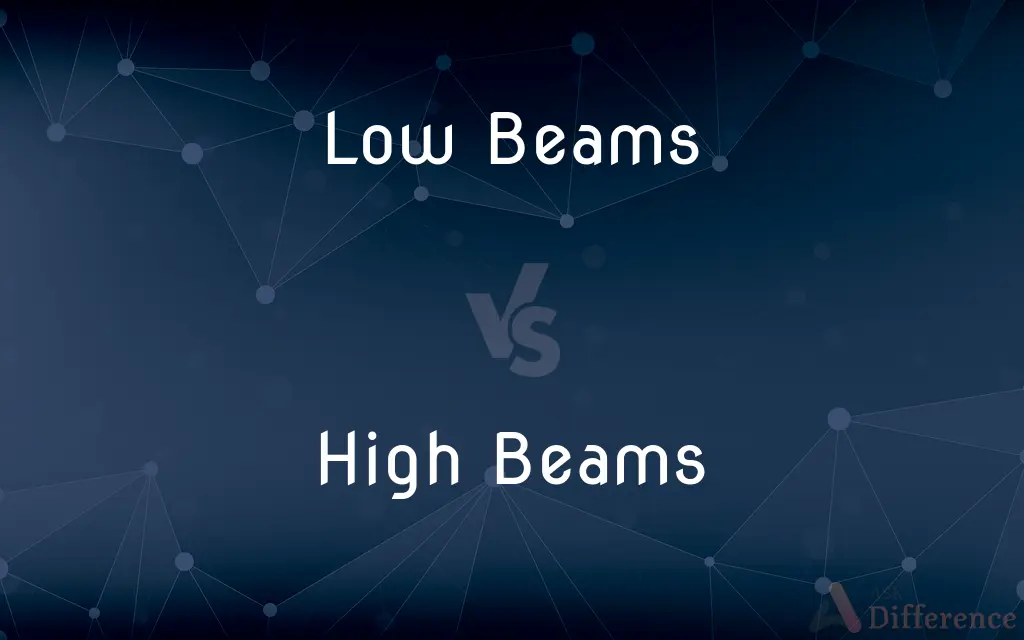Low Beams vs. High Beams — What's the Difference?
By Maham Liaqat & Fiza Rafique — Published on July 6, 2024
Low beams provide a wide, short range of light for normal night driving, illuminating the road without blinding oncoming traffic. High beams offer a long, narrow range of light for better visibility in dark, less-traveled areas but can dazzle others.

Difference Between Low Beams and High Beams
Table of Contents
ADVERTISEMENT
Key Differences
Low beams are designed to illuminate the road in front of a vehicle for a short distance without causing glare to oncoming drivers, making them suitable for most night driving situations, including in urban areas or on busy roads. High beams, on the other hand, project light farther ahead, enhancing a driver's visibility in dark conditions where there is less risk of blinding other road users, such as on open roads or in rural areas with minimal traffic.
The use of low beams is mandated in areas with significant traffic to prevent the bright, direct light of high beams from impairing the vision of other drivers. Conversely, high beams are recommended for use in poorly lit conditions where the beam can improve safety by revealing obstacles and hazards on the road ahead, without the risk of dazzling oncoming traffic.
Low beams distribute light in a specific pattern to maximize visibility without causing glare, typically illuminating the road up to 200 feet ahead. High beams can illuminate the road for a distance of 350 feet or more, providing a greater visibility range that helps in detecting potential hazards from a farther distance.
Switching between low and high beams is a critical driving skill, with drivers expected to use high beams judiciously to enhance night visibility while switching to low beams to avoid dazzling other road users. The decision on when to use each setting depends on traffic conditions, road layout, and weather, highlighting the importance of understanding the appropriate use of each beam type for safe driving.
Both beam types are essential for night driving, but they serve different purposes. Low beams are for general, everyday use, ensuring safety and visibility without impacting other drivers, whereas high beams are for specific situations where extended visibility is necessary, and there's minimal risk of affecting oncoming vehicles.
ADVERTISEMENT
Comparison Chart
Purpose
Safe driving in traffic by avoiding glare
Enhanced visibility in dark, empty roads
Visibility Range
Up to 200 feet
350 feet or more
Usage Conditions
Urban and busy roads
Open roads with little to no traffic
Effect on Oncoming Traffic
Minimal glare, safe for oncoming drivers
Can dazzle oncoming drivers if used improperly
Safety Aspect
Prevents blinding other drivers
Reveals obstacles and hazards from a distance
Compare with Definitions
Low Beams
Illuminate the road without causing glare to others.
Low beams ensure clear night vision in traffic.
High Beams
Provide extended visibility on dark, secluded roads.
High beams make rural night driving safer.
Low Beams
Suitable for most driving conditions.
Switch to low beams when another vehicle approaches.
High Beams
Illuminate a longer stretch of road ahead.
Use high beams to spot obstacles on open highways.
Low Beams
Prevents dazzling other drivers with direct light.
Low beams are courteous and safe for populated areas.
High Beams
Should be used when there's no oncoming traffic.
Switch off high beams when you see another vehicle approaching.
Low Beams
Designed for general night driving, providing safe visibility.
Use low beams in the city to avoid blinding oncoming traffic.
High Beams
Enhances safety by revealing distant hazards.
High beams help spot deer or other animals on the road.
Low Beams
Essential for driving in areas with significant traffic.
Always use low beams in urban settings at night.
High Beams
Ideal for conditions with minimal lighting.
High beams are beneficial on unlit country roads.
High Beams
Plural of high-beam
Common Curiosities
Can high beams be used in foggy conditions?
It's recommended to use low beams in fog, as high beams can reflect off the fog and reduce visibility further.
When should I use low beams vs. high beams?
Use low beams in populated areas or when there's oncoming traffic to avoid dazzling other drivers; use high beams in dark, unlit areas where there's minimal risk of impairing other road users' visibility.
How far do low beams illuminate?
Low beams typically illuminate the road up to 200 feet ahead of a vehicle.
Are high beams illegal in city driving?
While not necessarily illegal, using high beams in city driving can be considered improper use, as it can dazzle other drivers, leading to unsafe conditions.
Do all vehicles have separate bulbs for low and high beams?
Some vehicles use separate bulbs, while others use a single bulb with different filaments or mechanisms for low and high beams.
How do automatic high beam systems work?
Automatic high beam systems detect oncoming traffic and ambient light levels, automatically switching between high and low beams to optimize visibility and safety.
What's the main safety reason for switching between low and high beams?
The main safety reason is to maximize visibility without endangering or inconveniencing other road users, adapting to varying driving conditions and environments.
Why are low beams angled downwards?
Low beams are angled downwards to focus light on the road while minimizing glare for oncoming drivers.
How do weather conditions affect the use of high beams?
In clear conditions, high beams improve visibility, but in adverse weather conditions like fog or heavy rain, low beams are more effective and safer.
What is the penalty for misuse of high beams?
Penalties vary by location but can include fines and points on your driving record for improper use.
What should I do if an oncoming driver doesn't lower their high beams?
If faced with an oncoming driver not lowering their high beams, avoid looking directly into the lights and focus on the right edge of your lane until the vehicle passes.
Can I adjust the angle of my headlights?
Yes, most vehicles allow for the adjustment of headlight angles to ensure proper alignment for safe driving.
How do I know if my high beams are on?
Most vehicles have an indicator light on the dashboard, usually a blue symbol, to show when high beams are activated.
Can using high beams incorrectly result in fines?
Yes, improperly using high beams, such as by dazzling other drivers, can lead to fines in many jurisdictions.
Is it safe to drive with high beams on all the time?
No, driving with high beams on continuously can endanger oncoming drivers by impairing their vision, especially in areas with traffic.
Share Your Discovery

Previous Comparison
Urea vs. Thiourea
Next Comparison
Constructivism vs. Social ConstructivismAuthor Spotlight
Written by
Maham LiaqatCo-written by
Fiza RafiqueFiza Rafique is a skilled content writer at AskDifference.com, where she meticulously refines and enhances written pieces. Drawing from her vast editorial expertise, Fiza ensures clarity, accuracy, and precision in every article. Passionate about language, she continually seeks to elevate the quality of content for readers worldwide.













































